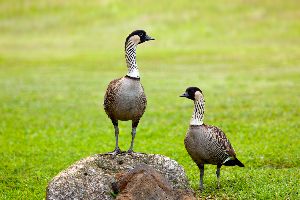
Hawaii is home to a variety of native and endemic species—those found only on the island chain. Though many made their way to the islands with the help of the first Polynesian settlers more than a thousand years ago, most of Hawaii’s biodiversity developed naturally. Sustaining and respecting the islands and their inhabitants became a tenet of Hawaiian culture. Unfortunately, the rise in human populations and infrastructure as explorers and colonizers found the islands threatened the vulnerable flora and fauna, a problem that continues today. Here is an overview of the islands’ ecosystems, along with what you can do to protect them.
Hawaii’s Remarkable Biodiversity
As an isolated island chain, Hawaii provided its plants, animals, insects, and marine life with unparalleled opportunities for evolution. Plant seeds arrived on the islands carried by the wind, sea, or birds, while animals swam or flew across the ocean. With few predators and not much competition, these species had millennia to adapt to their environments. For example, the ‘I’iwi, or scarlet honeycreeper, is believed to have developed its long, decurved beak to sip nectar from native flowers.
Threats to Endangered Species
Alien species, like rats and frogs, managed to sneak out to the islands on ships and goods, while others were introduced for human purposes, such as European pigs for consumption and mongooses for rat control. These more aggressive creatures preyed upon the natives, who had evolved no defenses, and quickly overtook them. Invasive plants likewise pushed out native greenery.
Invaders continue to infiltrate the islands with human intervention, such as through the plant and pet trades. An insect may hide within a plant and spread, while an irresponsible pet owner may lose or release an invasive fish or reptile.

Climate change has also affected the Hawaiian landscape and native species. Rising sea levels are eroding the beaches where sea turtles nest and monk seals breed, while increased temperatures have made avian malaria a pervasive threat to native birds. As a result of these ongoing factors, Hawaii is now home to more than 500 endangered species.
Conservation Efforts
The Hawaiians cared for and even revered the land and native species. Some animals were regarded as ʻaumākua, or ancestral guardians, of certain families; others were seen as manifestations of gods. The land’s resources were recognized as renewable if their limits were respected. The relationship between the people and the land was reciprocal and mutually beneficial.
Today, Hawaiian culture is an integral part of conservation. Local and government organizations have banded together to preserve the islands’ ecosystems by controlling invasive species—both limiting their entrance and eradicating their presence. Fighting global warming is also a primary goal for the sake of all residents, human or otherwise.
When visiting Hawaii, do your part to care for the land. Look for an operator certified by the Sustainable Tourism Association of Hawai‘i to show you the sights. Whether hiking or snorkeling, leave the spot as you found it, if not better—pick up any litter and dispose of it properly. If you encounter native species, observe them from a respectful distance.
When you want to explore Hawaiian culture and conservation, head to Waimea Valley in Haleiwa. The historic site features a botanical garden full of native plants and shelters endangered creatures, like the Hawaiian moorhen. Check out their conservation missions online, or call (808) 638-7766 to find out more about their educational programs.
About the Business
Have a question? Ask the experts!
Send your question

